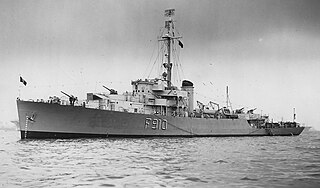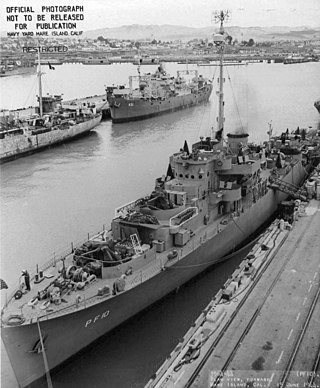The first USS Shreveport (PG-131/PF-23) was a Tacoma-class frigate of the United States Navy.

USS Sheboygan (PF-57) was a Tacoma-class frigate of the United States Navy which was later transferred to the Belgian Navy as Lieutenant ter zee Victor Billet.

USS Uniontown (PF-65), a Tacoma-class frigate, was the only ship of the United States Navy to be named for Uniontown, Pennsylvania.

USS Woonsocket (PF-32) was a Tacoma-class frigate in service with the United States Navy from 1944 to 1946. She was sold to Peru in 1947, where she served as BAP Gálvez (F-1/FE-1) until 1961.

USS Davenport (PF-69), a Tacoma-class frigate, was the only ship of the United States Navy to be named for Davenport, Iowa.
USS Hingham (PF-30), a Tacoma-class frigate, was the only ship of the United States Navy to be named for Hingham, Massachusetts. Hingham, originally designated PG-138, was launched under Maritime Commission contract by Walter Butler Shipbuilding Company in Superior, Wisconsin, on 27 August 1943, sponsored by Mrs. Katherine F. Harrington; and commissioned on 3 November 1944 after outfitting at Plaquemine, Louisiana. Her first commanding officer was Lieutenant Commander W. K. Earle, USCG.
USS Milledgeville (PF-94), a Tacoma-class frigate, was the first ship of the United States Navy to be named for Milledgeville, Georgia.
USS Manitowoc (PF-61), a Tacoma-class frigate in commission from 1944 to, was the first ship of the United States Navy to be named for Manitowoc, Wisconsin. After commissioned service in the U.S. Navy from 1944 to 1946. After her Navy service, she served in the United States Coast Guard for a few months in 1946. Sold to France in 1947, she commissioned into service in the French Navy as Le Brix (F715) in 1948 and operated as a weather ship until scrapped in 1958.

USS Alexandria (PF-18), originally classified PG-126, a Tacoma-class frigate, was the second ship of the United States Navy to hold that name, but it was the first to be named for the city of Alexandria, Virginia.

USS Lorain (PF-93), a Tacoma-class frigate, was the first commissioned ship of the United States Navy to be named for Lorain, Ohio.
USS Charlotte (PF-60), a Tacoma-class frigate, was the third ship of the United States Navy to be named Charlotte.

USS Brownsville (PG-118/PF-10), a Tacoma-class patrol frigate, was the only ship of the United States Navy to be named for Brownsville, Texas.

USS Muskegon (PF-24), a Tacoma-class frigate, was the first ship of the United States Navy to be named for Muskegon, a city on Michigan's west coast.

USS Groton (PF-29), a Tacoma-class frigate, was the first ship of the United States Navy to be named for Groton, Connecticut.

USS Bangor (PF-16) was a United States Navy Tacoma-class frigate in commission from 1944 to 1946. Thus far, she has been the only U.S. Navy ship named for Bangor, Maine. She later served in United States Coast Guard as USCGC Bangor and in the Mexican Navy as ARM General José María Morelos and ARM Golfo de Tehuantepec.

USS Covington (PF-56), a Tacoma-class frigate, was the third ship of the United States Navy to be named for Covington, Kentucky. Covington, with a United States Coast Guard crew, served as a weather ship off Newfoundland through early 1946. She was decommissioned in April 1946 and turned over to the U.S. Coast Guard and commissioned the same day as USCGC Covington (PF-56) and remained in service through September. She was returned to the U.S. Navy at that time and placed in reserve. In April 1947, she was struck from the Naval Vessel Register and, in August, sold to the Ecuadorian Navy. As BAE Guayas (E-21), she served as the flagship of the Ecuadorian Navy from her acquisition through 1967. She was decommissioned in 1972 and stricken in 1974.

USS Beaufort (PF-59) was a Tacoma-class frigate acquired by the United States Navy during World War II. Although she was designed as a patrol craft, she was reconfigured and employed as a weather station ship in the North Atlantic Ocean. Beaufort's task was to launch weather balloons and transmit weather data via radio to her shore-based commanders.

USS Wachapreague (AGP-8) was a motor torpedo boat tender in commission in the United States Navy from 1944 to 1946, seeing service in the latter part of World War II. After her Navy decommissioning, she was in commission in the United States Coast Guard from 1946 to 1972 as the cutter USCGC McCulloch (WAVP-386), later WHEC-386, the fourth ship of the U.S. Coast Guard or its predecessor, the United States Revenue Cutter Service, to bear the name. In 1972 she was transferred to South Vietnam and served in the Republic of Vietnam Navy as the frigate RVNS Ngô Quyền (HQ-17). Upon the collapse of South Vietnam at the end of the Vietnam War in 1975, she fled to the Philippines, and she served in the Philippine Navy from 1977 to 1985 as the frigate RPSGregorio del Pilar (PF-8) and from 1987 to 1990 as BRP Gregorio del Pilar (PF-12).
The second USS Brunswick (PF-68) was a United States Navy Tacoma-class frigate in commission from 1944 to 1946.

USS Greensboro (PF-101) was a United States Navy Tacoma-class frigate in commission from 1945 to 1946.













